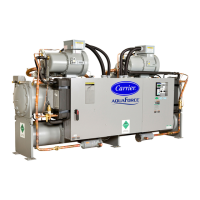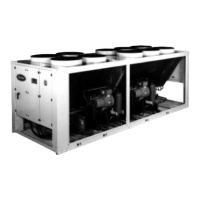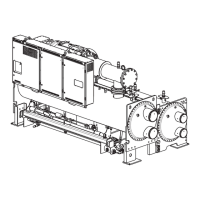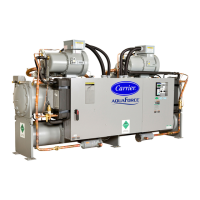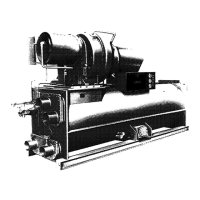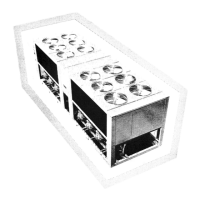TROUBLESHOOTING
The 30GX,HX screw chiller control has many features to
aid in troubleshooting. By using the keypad and display mod-
ule and the Status function, operating conditions of the chiller
are displayed while the unit is running. The Test function
allows for operational checkout of compressor loaders, fans,
EXVs, solenoids, and other components while the chiller is
stopped. The Service function displays how configurable items
are configured and provides a manual control mode where
the compressors can be started and loaded. If an operating
fault is detected, an alarm is generated and an alarm code
is displayed under the subfunction along with an
explanation of the fault. Up to 10 current alarm codes are
stored under this subfunction. For checking specific items,
see Table 10.
Checking Display Codes — To determine how the
machine has been programmed to operate, check the diag-
nostic information displayed in the Status function and the
configuration information displayed in the Service function.
Unit Shutoff — To shut the unit off, move the LOCAL/
OFF/REMOTE switch to OFF position.All compressors and
solenoids stop immediately.
Complete Unit Stoppage — Complete unit stoppage
can be caused by any of the following conditions:
• cooling load satisfied
• remote on/off contacts open
• programmed schedule
• emergency stop command from CCN
• general power failure
• blown fuse in control power feed disconnect
• open control circuit fuse(s)
• LOCAL/OFF/REMOTE switch moved to OFF position
• freeze protection trip
• low flow protection trip
• open contacts in chilled water flow switch (optional)
• Open contacts in any auxiliary interlock. Terminals that
are jumpered from factory are in series with control switch.
Opening the circuit between these terminals places unit in
Stop mode, similar to moving the control switch to OFF
position. Unit cannot start if these contacts are open. If
they open while unit is running, the unit stops
• cooler entering or leaving fluid thermistor failure
• low/high transducer supply voltage
• loss of communications between processor module and other
control modules
• low refrigerant pressure
• off-to-on delay is in effect
If a stoppage occurs more than once as a result of any
of the above safety devices, determine and correct the
cause before attempting another restart.
Single Circuit Stoppage — Single circuit stoppage
can be caused by the following:
• low oil pressure
• open contacts in high pressure switch
• low refrigerant pressure
• thermistor failure
• transducer failure
• alarm condition from CPM module
• Overload relay trip. Stoppage of one circuit by a safety
device action does not affect other circuit. When a safety
device trips, the circuit is shut down immediately and EXV
closes
If a stoppage occurs more than once as a result of any
of the preceding safety devices, determine and correct
the cause before attempting another restart.
Restart Procedure — After the cause for stoppage has
been corrected, restart is either automatic or manual, de-
pending on the fault. Manual reset requires that the alarm(s)
be reset via the HSIO. Press and then to
clear manual reset alarms. If the Alarm Reset Select feature
is selected ( ), a manual reset alarm can also be reset
by switching the LOR switch from LOCAL/REMOTE to OFF
and back to LOCAL/REMOTE again. If an alarm was from
the CPM module, depress the reset button located on the HSIO
or fuse bracket before clearing the alarm through the HSIO.
Some typical fault conditions are described in Table 32. For
a complete list of fault conditions, codes, and reset type, see
Table 33.
POWER FAILURE EXTERNAL TO THE UNIT — Unit
restarts automatically when power is restored.
Table 32 — Typical Stoppage Faults
and Reset Types
STOPPAGE FAULT RESET TYPE
Loss of Condenser Flow (30HXC) Manual reset
Cooler Freeze Protection
(Chilled Fluid, Low
Temperature)
Auto reset first time, manual if
repeated in same day
Chilled Fluid Pump Interlock Automatic reset (Manual for
closed contacts when pump is off)
Control Circuit Fuse Blown Unit restarts automatically when
power is restored
High-Pressure Switch Open Manual reset
Low Sat. Suction Temperature Manual reset
Low Oil Pressure Manual reset
Loss of Communications with
WSM or FSM controller
Automatic reset
LEGEND
FSM — Flotronic™ System Manager
WSM — Water System Manager
Alarms and Alerts — These are warnings of abnormal
or fault conditions, and may cause either one circuit or the
whole unit to shut down. They are assigned code numbers as
described in Table 33. The alarm descriptions are displayed
on the HSIO when the subfunction is entered. When
a communication loss occurs to a hardware point, an alert or
alarm may be generated. Refer to Table 34. The PSIO also
recognizes illegal configurations. Illegal configurations are
shown in Table 35.
Table 33 contains a detailed description of each alarm and
alert code error and possible cause. Manual reset is
accomplished by entering from the HSIO and press-
ing or moving the LOCAL/OFF/REMOTE Switch
to the OFF position, then back to LOCAL or REMOTE po-
sition (If Alarm Reset Select is enabled).
Compressor Alarm/Alert Circuit — Each compres-
sor is controlled by its own CPM processor, which closes
contacts between plug terminals PL2-3 and PL2-6 to start
the compressor. Power is supplied to the CPM logic circuit
through each compressor high-pressure switch and into plug
terminal PL2-2. If the high-pressure switch opens, the CPM
generates an alarm.
NOTE: Similar connections for each compressor can be fol-
lowed on the unit wiring diagrams located on the unit.
43

